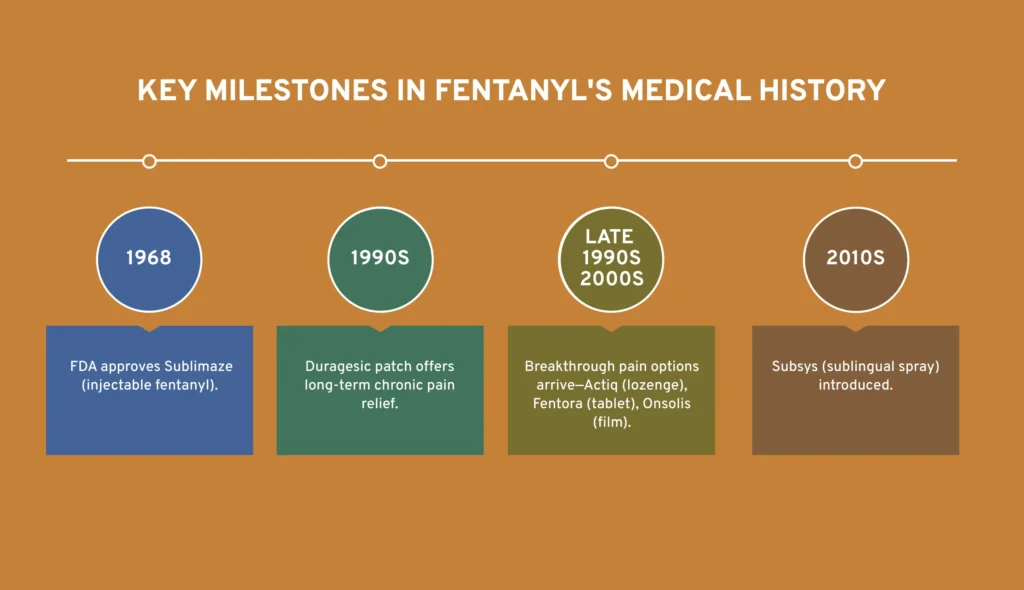Few drugs in modern medicine have a story as complex as fentanyl. Today, headlines often associate it with overdose deaths and the opioid epidemic. Yet when it was first created, fentanyl was celebrated as a medical innovation, a powerful tool for managing pain in surgeries and critical care. Understanding the history of fentanyl is not just about knowing who invented fentanyl or when fentanyl was first introduced.
It’s about tracing how a laboratory discovery intended to ease suffering evolved into one of the most pressing public health challenges of our time.
Who Created Fentanyl and When Was It Invented?
Fentanyl was first synthesized around 1959–1960 by Dr. Paul Janssen, a Belgian chemist and founder of Janssen Pharmaceutica. At the time, Janssen was searching for a new type of painkiller that was stronger and faster-acting than existing opioids like morphine and meperidine. His team discovered fentanyl, known in the lab as compound R-4263, which showed remarkable potency at very low doses.
By the late 1960s, fentanyl was already gaining traction in hospitals. In 1968, the U.S. Food and Drug Administration (FDA) approved Sublimaze, the first intravenous formulation of fentanyl for use in surgical anesthesia. From this point forward, fentanyl became an essential tool in medicine.
Why Was Fentanyl Created? Its Original Purpose
The invention of fentanyl was not accidental. Janssen specifically designed it as a potent analgesic for use in operating rooms, where doctors needed a drug that could relieve severe pain quickly and effectively. Unlike morphine, which required larger doses, fentanyl worked in micrograms, a fraction of the amount needed to produce similar effects.
Fentanyl’s rapid onset and short duration made it perfect for anesthesia, particularly during complex surgeries. Doctors valued it because it allowed for precise control over pain without prolonged sedation. In other words, fentanyl was created to be a safer, more efficient tool for modern medicine.

The Fentanyl Timeline
After its approval in the 1960s, fentanyl’s story didn’t stop there. Over the next decades, scientists and pharmaceutical companies developed new formulations to meet the growing need for pain management, particularly among cancer patients.
Key milestones in the medical history of fentanyl include:
- 1968: FDA approves Sublimaze (injectable fentanyl).
- 1990s: Duragesic transdermal patch becomes widely available, offering long-term relief for chronic pain.
- Late 1990s – 2000s: Breakthrough pain medications emerge, such as Actiq (oral lozenge), Fentora (buccal tablets), and Onsolis (film strips).
- 2010s: Newer delivery systems like Subsys (sublingual spray) are introduced.
Each of these products was designed with a specific patient group in mind, ranging from post-surgical care to terminal cancer pain. By the early 2000s, fentanyl had become one of the most widely prescribed opioids in the world.
What Makes Fentanyl So Potent?
Chemically, fentanyl belongs to the class of synthetic opioids. Unlike natural opioids derived from the poppy plant, synthetic opioids are fully man-made in labs.
Fentanyl binds strongly to µ-opioid receptors (pronounced “mu-opioid receptor,” is a protein found on the surface of nerve cells in the brain, spinal cord, and other parts of the body.) in the brain, the same receptors that control pain and emotion.
What sets fentanyl apart is its extreme potency. It is estimated to be 50 to 100 times stronger than morphine. Its lipid solubility allows it to cross the blood–brain barrier quickly, leading to a rapid onset of pain relief. For patients in severe pain, this potency is a blessing. But outside medical supervision, it becomes incredibly dangerous, just a few milligrams can be fatal.
From Prescription to Illicit Drug: The Turning Point
For decades, fentanyl was mainly associated with hospitals and specialized pain management. But by the 2000s, a new chapter began, the rise of illicit fentanyl.
Initially, diversion of pharmaceutical products such as patches and lozenges contributed to misuse. Over time, criminal networks began manufacturing fentanyl illegally, often in clandestine labs outside the U.S. This illicit fentanyl was then mixed into counterfeit pills or cut into heroin and cocaine, creating a deadly combination for unsuspecting users.
The 2010s marked a dramatic surge in fentanyl-related deaths. By 2013, the U.S. Centers for Disease Control and Prevention (CDC) began tracking a sharp rise in fatalities tied to illicitly manufactured fentanyl (IMF). Today, fentanyl is at the center of the opioid epidemic, responsible for tens of thousands of deaths annually.
Why Are Drugs Laced with Fentanyl?
One of the most disturbing trends is the intentional lacing of other drugs with fentanyl. The reasons are largely economic: fentanyl is cheap to produce, requires only tiny amounts to create a powerful effect, and boosts the potency of weaker drugs.
Unfortunately, this practice has devastating consequences. Users may believe they are taking a prescription pill or heroin, only to consume a lethal dose of fentanyl. This unpredictability is one of the main drivers of overdose deaths in recent years.
Global Supply Chains: How Fentanyl Travels
Illicit fentanyl doesn’t just appear on the streets, it has a global supply chain. Precursor chemicals often originate in China, where they are shipped to Mexico, where cartels operate labs to convert them into finished fentanyl. From there, the drug is trafficked into the United States and beyond.
The DEA (Drug Enforcement Administration) and the UN Office on Drugs and Crime (UNODC) have identified this chain as one of the most significant drivers of fentanyl availability worldwide. The speed and scale of this trafficking make fentanyl harder to control than plant-based opioids like heroin.
The Human Toll: Fentanyl and the Opioid Crisis
The rise of fentanyl has reshaped the opioid epidemic. According to CDC data, overdose deaths involving synthetic opioids increased sharply after 2013, with fentanyl leading the surge. Unlike prescription opioids, where doses are controlled, illicit fentanyl often varies wildly in concentration, leaving users at constant risk.
While naloxone can reverse fentanyl overdoses, its potency sometimes requires multiple doses, making emergency response even more critical. Communities, Rehab centers, hospitals, and public health systems continue to struggle with the scale of this crisis.
Regulatory and Legal steps
To combat misuse, fentanyl was classified as a Schedule II controlled substance in the U.S., meaning it has legitimate medical uses but a high potential for abuse. In recent years, governments worldwide have taken steps to control its precursors and analogs.
- The U.S. has enacted tighter regulations and expanded law enforcement against fentanyl trafficking.
- China announced controls on fentanyl-related substances in 2019, aiming to curb international trafficking.
- International agencies like UNODC continue to monitor and regulate global flows of synthetic opioids.
What is the history of fentanyl?
Fentanyl was first synthesized in 1959 by Belgian chemist Dr. Paul Janssen. It was introduced as a powerful painkiller in the 1960s and became widely used in medical settings for anesthesia and chronic pain management.
Where does fentanyl come from?
Fentanyl is a fully synthetic opioid, meaning it is made in laboratories rather than derived directly from the opium poppy. Today, both legal pharmaceutical companies and illegal labs produce it.
What is fentanyl properly used for?
Medically, fentanyl is used to manage severe pain—especially in cancer patients, post-surgery, and in cases where other opioids are not effective.
Which drug company produces fentanyl?
The first company to produce fentanyl was Janssen Pharmaceutica, founded by Dr. Paul Janssen. Today, several pharmaceutical companies manufacture prescription fentanyl under strict regulation.
Why is fentanyl used in surgery?
Fentanyl is used during surgery because it acts quickly, provides powerful pain relief, and helps maintain patient comfort under anesthesia. Its fast onset and short duration make it highly effective in controlled medical environments.


